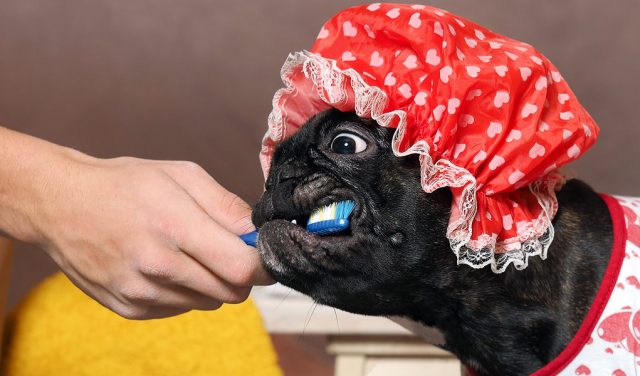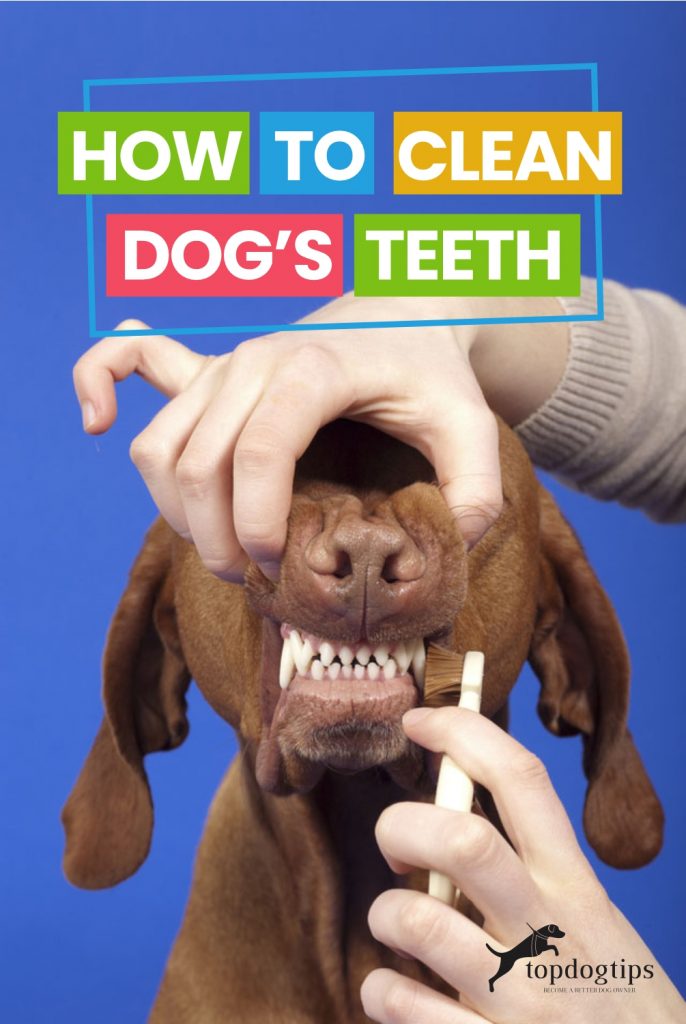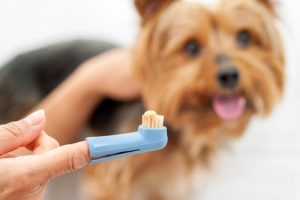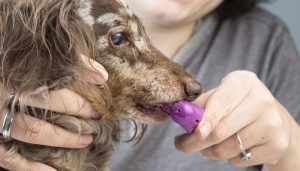
Did you know that dog teeth brushing is not only a matter of your pet's dental hygiene and preventing bad breath, but it also affects his whole body health? Poor dental hygiene in dogs and potential gum disease can contribute to many serious health conditions, including heart disease, according to AVDC. In this article, we'll discuss how you can prevent your dog's poor dental health and improve his overall health as a result by implementing regular teeth brushing.
Table of Contents
Did you know that statistically, periodontal disease in dogs is the most common health condition found in adult canines? The sad part is that this is a preventable disease.
 It's unfortunate that most dog owners don't realize that regular teeth brushing can aid in their dog's overall health and well-being and possibly add years to his life. This is mostly due to the elimination and control of harmful bacteria in the dog's mouth (source).
It's unfortunate that most dog owners don't realize that regular teeth brushing can aid in their dog's overall health and well-being and possibly add years to his life. This is mostly due to the elimination and control of harmful bacteria in the dog's mouth (source).
If you have never done this before, it can be intimidating to learn how to brush a dog's teeth. Your Fido likely won't be happy with this procedure at first, nor is he going to be excited every time you take out his doggy toothbrush, but if you ease into things gradually, he'll eventually learn how to tolerate the whole process of brushing teeth.
You'll also need the right equipment, which includes dog-specific toothpaste and a toothbrush that's made for dogs. Samantha has done an extensive write-up on how to choose the right type of dog toothbrush for brushing your dog's teeth.
Never use human toothpaste on dogs since the components will be toxic. The same should be said about human toothbrushes since some of them will not work well for your dog's teeth, especially gums.
They make dog toothpaste in enticing flavors like chicken and beef. Hopefully, these flavors will make your pet more willing to open up and let you work on his teeth. If you need more help on brushing your dog's teeth with specific examples before we jump into the full step-by-step process, then check out the below-linked video guide.
FULL GUIDE: How To Brush A Dog’s Teeth 101 – An Instructional Guide
6-Step Checklist for Dog Teeth Brushing
 Step 1: Get Your Dog's Dental Equipment
Step 1: Get Your Dog's Dental Equipment
Brushing your dog’s teeth means starting off with the right equipment on hand because you can't use your own toothpaste (although your own unused toothbrush can still work).
Fortunately, all you need for brushing the teeth of your pet is a simple and cheap dog toothbrush and a dog-friendly toothpaste. You can purchase these things at your local pet supply store or from online retailers. Here are the ten best dog toothbrushes and ten best dog kinds of toothpaste that work well.
Again, whatever you choose for brushing your dog's teeth, make sure that you ONLY use dog-specific toothpaste, as human toothpaste options can be harmful to your dog’s health.
When picking a toothbrush for your dog, you will have a few different options, as you can see in the above-linked lists of the ten best choices. Usually, dog owners prefer either a regular toothbrush or a fingertip toothbrush that fits right over the tip of your finger.
Fingertip toothbrushes for dogs can be easier for pet owners to use; however, when used on dogs that seriously do not like having their teeth brushed, they can put their owners at risk of being accidentally bitten. Test what works with your dog using a cheaper option.
Step 2: Prepare Your Dog for Brushing
You should begin preparing your dog to have his teeth brushed regularly from the moment you bring him home. Ideally, start when he's still a puppy. Most dog parents do not get their pets used to teeth brushing, which is when it becomes a struggle later on.
Preparing a dog to have his teeth brushed when he is not used to it is important no matter what age the dog. Even if you have had your canine for five years and are just now starting to brush your teeth, you need to begin with the very basics. This means introducing Fido to his toothpaste and toothbrush gradually so as not to induce fear.
Introducing your dog to his toothbrush means letting him investigate the tool himself. Allow your dog to sniff it and touch it with his mouth; then, put a little toothpaste on it to encourage him to investigate further. This also allows him to taste the toothpaste and get used to the smell and the looks.
If your dog is amenable, you can also touch his teeth with the toothbrush and gently brush them, but just a little. What you should NOT do during this introductory phase is rigorously brush your dog’s teeth or force the toothbrush into his mouth. You do not want to do anything that will cause him to become fearful of the toothbrushing process.
It will take quite a few sessions for your dog to get used to his toothbrush, toothpaste, and the whole process itself. During this time, make sure that you remain patient and persist with the introductory process no matter how long it takes. You'll be glad you did.
Step 3: First Time Brushing Your Dog’s Teeth
Once your dog has become relatively comfortable with his toothbrush and toothpaste, it's time to embark on your first proper tooth-brushing session. Don't go into this expecting to be able to clean every one of your dog’s teeth thoroughly, just as you do it with your teeth.
Remember that your dog is not totally comfortable with this process yet – he does not know what you are doing or what to expect. Begin by putting a small amount of toothpaste (as you see in the above video) onto the dog toothbrush. Make sure that your puppy is in a comfortable position where he can relax in the meantime.
Now, sit beside him and gently peel back his lip. Begin with one side of the mouth, lifting the side of the lip – this is the most comfortable of positions, so always start with this one.
Lift the lip very slowly, gently, and carefully brush the teeth that are visible to you. This means that you will be brushing the top teeth since the bottom teeth will likely be covered or partially covered by the top teeth. Using the toothbrush, brush in small circles; don't brush too vigorously, as discomfort will cause your pup to pull away.
Here's an important tip: your first tooth-brushing session can be very stressful for your dog, so it is best to brush just one side of your teeth and then leave the rest of the job for another time. As Fido gets more used to dog teeth brushing, you can increase the time you spend brushing and focus on cleaning all the teeth in one sitting.
Expect that it will take about 2-4 weeks of gradual progress until you're able to brush all of your pet's teeth in just one sitting without him putting up too big of a fight.
Step 4: Create a Routine for Brushing Dog’s Teeth
After those 2-4 weeks, and once your dog becomes used to the process of having his teeth brushed, your next goal should be to have all the teeth brushed in one sitting. This can be tricky for you to do simply because of how the teeth are set in your pet’s mouth.
Here are the steps for the full process. Begin as before by lifting the lip and brushing the top teeth in a circular motion. After that, you need to open your dog’s mouth a little more without being forceful. Repeat the circular brushing process on the bottom teeth.
Now, repeat the top and bottom brushing on the opposite side of the mouth, being sure to focus on any areas of dog teeth plaque. With both sides of his teeth brushed, don’t forget to brush the front teeth, too. Gently lift the lip and brush carefully in small circles.
It is particularly important to be very slow and gentle while brushing these small teeth because the dog's gums can be irritated very easily. It is also essential not to push up the top lip too far – this can cause your discomfort, and he'll most likely start sneezing.
READ MORE: Dog Teeth Cleaning 101 – How To Clean Dogs' Teeth
Step 5: After Dog Teeth Brushing Is Done
Whether it is the first time or 50th time that you're brushing your dog’s teeth, always praise him, pet him, and reward him for allowing you to clean his teeth. Tooth brushing in dogs is a regular routine that your pet needs to be used to and be willing to undergo on a regular basis, and there's no better way to ensure future success as positive associations.
Remember that rewards to your pooch aren’t limited to dog treats. You can reward your dog for sitting through a tooth brushing session with a game of fetch, or just spending some extra time with him, scratching him behind the ear, or doing something else that he loves (maybe he loves being brushed?)
Step 6: Rinse and Repeat
The last step is very simple – remember to repeat the process in the exact same way you did when your dog allowed you to brush his teeth. Keeping the routine is vital with dogs.
Once your pet has become used to dog teeth brushing on a regular basis, make a habit to perform complete teeth cleaning every day. Unfortunately, for too many dog owners, this remains just a goal to strive for but never to achieve.
So if your dog isn’t quite as accommodating to having his teeth brushed every single day (or it's you who's too busy lazy), aim for at least three times a week. But in that case, remember to supplement brushing with dog dental water additives and/or dental dog treats, dental doggy toys, and chews like Greenies to reduce plaque buildup.
A Word to the Wise
 Some dog owners turn to using tooth scalers at home to eliminate plaque buildup on their dog’s teeth. While dental pet scalers such as this one can remove plaque, they also scratch the surface of the dog’s teeth and make it easier for bacteria to take hold. I would advise discussing this with your vet.
Some dog owners turn to using tooth scalers at home to eliminate plaque buildup on their dog’s teeth. While dental pet scalers such as this one can remove plaque, they also scratch the surface of the dog’s teeth and make it easier for bacteria to take hold. I would advise discussing this with your vet.
However, this is why dentists always polish teeth to create a smooth surface after they scale them, and you can't really do this with your dogs, especially on a daily basis. In my opinion, it's best to leave dental scaling to the professionals and stick to regular dog teeth brushing, dental treats and toys, and safe bones for dogs to promote your dog’s dental health.
I hope this simple six-step checklist was helpful. If you're more of a visual learner, you can check out our quick video guide on how to brush a dog's teeth I posted above. It discusses all the necessary dog supplies you'll need for brushing their teeth and shows you exactly how to use them. You'll learn how to use proper technique and some of Samantha's best tips and tricks for making this grooming task go as smoothly as possible. Good luck!
READ NEXT: Dog Teeth Cleaning 101 – Brushing Dogs' Teeth















